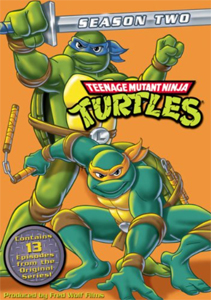Lead writer David Wise skillfully morphed Mirage Comics’ version of the “Teenage Mutant Ninja Turtles” into kid-friendly cartoon form in 1987’s five-episode Season 1, a complete arc that hits on many of the story beats of the “Original 16” Mirage comics.
For 1988’s Season 2 (which initially aired on Saturdays before moving into the weekday rotation), the cartoon team had fewer comics left to strip-mine, and they didn’t want to keep mining them anyway. They wanted to focus on their own show with its own identity, as established by Wise.
Eastman & Laird had more say in the cartoon than some might think (the Playmates toys designs, and therefore the cartoon designs, came from Mirage itself), and they have expressed regret that the show got away from them pretty quickly.

“Teenage Mutant Ninja Turtles” Season 2, episodes 1-5 (1988)
Syndicated
Episodes: “Return of the Shredder,” “The Incredible Shrinking Turtles,” “It Came from Beneath the Sewers,” “The Mean Machines,” “Curse of the Evil Eye”
Producers: Fred Wolf, Walt Kubiak
Writers: Christy Marx, David Wise, Patti Howeth (1); Larry Parr (2, 3); Michael Reaves (4), Martin Pasko (5)
This is partly because it was produced lightning fast for an animated show. There are two broad theories about why Season 2 is a rougher product than the pretty strong Season 1. One, Season 2 is sloppily cranked out by people who don’t care, or 2, everyone did the best they could while under insane time pressure. I subscribe to theory No. 2.
‘Donatello’ issue provides the maguffin
Wise provides the story for “Return of the Shredder” (episode 1, written by Christy Marx) but then steps away. A whole new roster of writers then learns on the fly. They start off with one last strip-mining of a Mirage idea: the magic crystal from the 1986 “Donatello” one-shot, which serves as the maguffin for episodes 2-5, the “Eye of Sarnath” arc. (The issue would later be directly adapted to the cartoon continuity in the1990 storybook “The Magic Crystal.”)
The “Donatello” issue “Kirby and the Warp Crystal” is ultra meta, a tribute to comic artist Jack Kirby that plays with the notion that his pencil must’ve been possessed by a magic gem, so good are his drawings. Everything he draws comes to literal life. (Though seemingly a one-off, the crystal would play a major role in April’s life in Laird’s Volume 4 two decades later.)
The “TMNT” toon is meta only in the blunt fashion that it knows it’s a TV show. For instance, “Return of the Shredder” ends with April winking on live TV at the Turtles. Watching in the sewer lair, the Turtles argue about who she was winking at, and April then says “I was winking at Splinter.” Splinter then turns to us, the viewing audience, and says “Age has its privileges.”

The cartoon is also hyper-aware of recent movies, as evident throughout the “Eye of Sarnath” arc. Considering that E&L themselves riffed on the “Daredevil” comics, we can argue that parodies/homages are in the “TMNT” tradition, but it could also be that the writers didn’t have time to dream up original stories.
“Return of the Shredder” riffs on “The Karate Kid” (1984), as Shredder takes over a dojo and turns it evil. “The Incredible Shrinking Turtles” (2, Larry Parr) likely had “Innerspace” (1987) on its mind. “It Came from Beneath the Sewers” (3, Parr) and its killer plant come from “Little Shop of Horrors” (1986). “The Mean Machines” (4, Michael Reaves) owes a lot to Michael Crichton’s “Runaway” (1984), about machines running amok. “Curse of the Evil Eye” (5, Martin Pasko) is a descendant of every “wishes come true” movie, and it’s notable that “Big” came out earlier in 1988.
Rushed teleplays
The “Eye of Sarnath” arc shows that a connected arc isn’t easy to do when under time pressure and when four writers collaborate. Perhaps the experience drove off a few of them. Marx and Parr wouldn’t return to the show, and Pasko wrote only one more episode. Reaves, however, went on to write many classic episodes; he’s also a legend for his “Batman: The Animated Series” and “Star Wars” Legends works.
“Shrinking Turtles” establishes – via an alien who crash-lands and tells the Turtles a deathbed tale – that there are three pieces of the Eye; put them together to achieve unlimited power (or alternately, keep them apart to avoid Shredder getting unlimited power). After that was written, they realized there are four Sarnath episodes, so there should’ve been four shards. The inane workaround is that Baxter inexplicably loses the first shard off-screen and he and Shredder have to reacquire it in “Beneath the Sewers.”
Another example of rushed writing comes in “Curse” when Donatello announces that if the Sarnathometer (his tracking device) and the completed Eye come in contact, they’ll form a bomb. There’s no way for him to know this.
While it’s true that Season 1 has plenty of story conveniences, those episodes are fast-paced and action-packed so the contrivances come off as “all in good fun.” In early Season 2, they’re due to rushed scripting. And one broad convenience isn’t even fun: Shredder and Baxter have no help from Bebop, Rocksteady and the Foot Soldier army simply because Krang thinks its amusing to not help Shredder.
And the show thinks it’s amusing that Shredder is Krang’s lapdog, regularly reporting back to him in Dimension X, and that Shredder then takes out his frustrations on his lone ally, Baxter. The sniveling mad scientist finally has had enough, and strikes out on his own in “Curse,” the best of the arc because it’s relatively bursting with character development – for Baxter and for Blodgett, a poor schmo of a Channel 6 assistant who briefly gets hold of the wish-granting Eye.
I’ve heard it explained that Krang is busy with his war in Dimension X and that the Technodrome couldn’t get back to Earth anyway, due to a power-supply issue, but neither of these things are in the text itself.
A letdown after Season 1
The animators – themselves piling on tons of “wrong mask color/wrong voice” mistakes – actually help Shredder a little. In “Curse,” he loses his helmet and we see the face of a physically powerful, confident-looking young Japanese ninja.
Although the Playmates toys (as designed by Mirage Studios) and the cartoon worked together, it’s humorously evident that inter-office communication was not a strong suit. The sniveling genius Baxter is a distinct villain, and one of the few characters to have an organic arc, yet he never got a Playmates action figure in human form. (NECA produced a human Baxter in the Playmates style in 2022).
Also in this arc, Channel 6’s Burne (J. Jonah Jameson-esque), Vernon (bossy but ultimately a coward) and Irma (man-obsessed) get their characterizations locked in. They would eventually become action figures, but not until five years later, an eon in Kid Time.
Watching the episodes in syndicated rotation, I never got excited about the “Eye of Sarnath” arc popping up after “The Epic Begins” (a.k.a. Season 1). My criticism was the shortage of action figure and vehicle introductions. But even being unfamiliar with the Eighties movies being ripped off, there’s something inherently generic about these episodes.
I watched Season 1 with a genuine smile, and the “Sarnath” arc with an expression approaching a grimace. Sure, it’s still fun to notice lines of dialog that stuck in my head, and to experience entire chunks of story that had left my brain. The “TMNT” cartoon world is slowly getting built up, particularly with the Channel 6 news crew and Baxter, but the fact that Krang chooses to sit back and watch is as irksome to a viewer as it is to Shredder.

